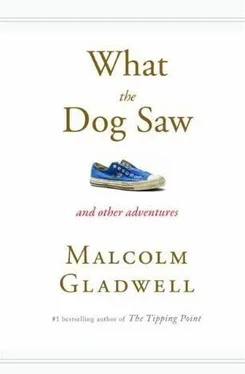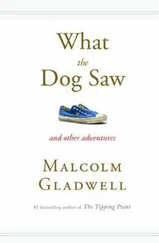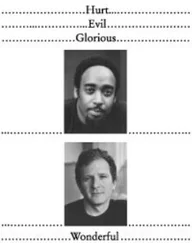On the surface, the FBI’s system seems extraordinarily useful. Consider a case study widely used in the profiling literature. The body of a twenty-six-year-old special-education teacher was found on the roof of her Bronx apartment building. She was apparently abducted just after she left her house for work, at six-thirty in the morning. She had been beaten beyond recognition and tied up with her stockings and belt. The killer had mutilated her sexual organs, chopped off her nipples, covered her body with bites, written obscenities across her abdomen, masturbated, and then defecated next to the body.
Let’s pretend that we’re an FBI profiler. First question: race. The victim is white, so let’s call the offender white. Let’s say he’s in his midtwenties to early thirties, which is when the thirty-six men in the FBI’s sample started killing. Is the crime organized or disorganized? Disorganized, clearly. It’s on a rooftop, in the Bronx, in broad daylight—high risk. So what is the killer doing in the building at six-thirty in the morning? He could be some kind of serviceman, or he could live in the neighborhood. Either way, he appears to be familiar with the building. He’s disorganized, though, so he’s not stable. If he is employed, it’s blue-collar work at best. He probably has a prior offense, having to do with violence or sex. His relationships with women will be either nonexistent or deeply troubled. And the mutilation and the defecation are so strange that he’s probably mentally ill or has some kind of substance-abuse problem. How does that sound? As it turns out, it’s spot-on. The killer was Carmine Calabro, age thirty, a single, unemployed, deeply troubled actor who, when he was not in a mental institution, lived with his widowed father on the fourth floor of the building where the murder took place.
But how useful is that profile really? The police already had Calabro on their list of suspects: if you’re looking for the person who killed and mutilated someone on the roof, you don’t really need a profiler to tell you to check out the disheveled, mentally ill guy living with his father on the fourth floor.
That’s why the FBI’s profilers have always tried to supplement the basic outlines of the organized/disorganized system with telling details—something that lets the police zero in on a suspect. In the early 1980s, Douglas gave a presentation to a roomful of police officers and FBI agents in Marin County about the Trailside Killer, who was murdering female hikers in the hills north of San Francisco. In Douglas’s view, the killer was a classic disorganized offender—a blitz attacker, white, early to midthirties, blue collar, probably with “a history of bed-wetting, fire-starting, and cruelty to animals.” Then he went back to how asocial the killer seemed. Why did all the killings take place in heavily wooded areas miles from the road? Douglas reasoned that the killer required such seclusion because he had some condition that he was deeply self-conscious about. Was it something physical, like a missing limb? But then how could he hike miles into the woods and physically overpower his victims? Finally, it came to him: “ ‘Another thing,’ I added after a pregnant pause, ‘the killer will have a speech impediment.’”
And so he did. Now, that’s a useful detail. Or is it? Douglas then tells us that he pegged the offender’s age as early thirties and he turned out to be fifty. Detectives use profiles to narrow down the range of suspects. It doesn’t do any good to get a specific detail right if you get general details wrong.
In the case of Derrick Todd Lee, the Baton Rouge serial killer, the FBI profile described the offender as a white male blue-collar worker between twenty-five and thirty-five years old who “wants to be seen as someone who is attractive and appealing to women.” The profile went on, “However, his level of sophistication in interacting with women, especially women who are above him in the social strata, is low. Any contact he has had with women he has found attractive would be described by these women as ‘awkward.’” The FBI was right about the killer being a blue-collar male between twenty-five and thirty-five. But Lee turned out to be charming and outgoing, the sort to put on a cowboy hat and snakeskin boots and head for the bars. He was an extrovert with a number of girlfriends and a reputation as a ladies’ man. And he wasn’t white. He was black.
A profile isn’t a test, where you pass if you get most of the answers right. It’s a portrait, and all the details have to cohere in some way if the image is to be helpful. In the mid-nineties, the British Home Office analyzed 184 crimes to see how many times profiles led to the arrest of a criminal. The profile worked in five of those cases. That’s just 2.7 percent, which makes sense if you consider the position of the detective on the receiving end of a profiler’s list of conjectures. Do you believe the stuttering part? Or do you believe the thirty-year-old part? Or do you throw up your hands in frustration?
There is a deeper problem with FBI profiling. Douglas and Ressler didn’t interview a representative sample of serial killers to come up with their typology. They talked to whoever happened to be in the neighborhood. Nor did they interview their subjects according to a standardized protocol. They just sat down and chatted, which isn’t a particularly firm foundation for a psychological system. So you might wonder whether serial killers can really be categorized by their level of organization.
Not long ago, a group of psychologists at the University of Liverpool decided to test the FBI’s assumptions. First, they made a list of crime-scene characteristics generally considered to show organization: perhaps the victim was alive during the sex acts, or the body was posed in a certain way, or the murder weapon was missing, or the body was concealed, or torture and restraints were involved. Then they made a list of characteristics showing disorganization: perhaps the victim was beaten, the body was left in an isolated spot, the victim’s belongings were scattered, or the murder weapon was improvised.
If the FBI was right, they reasoned, the crime-scene details on each of those two lists should co-occur —that is, if you see one or more organized traits in a crime, there should be a reasonably high probability of seeing other organized traits. When they looked at a sample of a hundred serial crimes, however, they couldn’t find any support for the FBI’s distinction. Crimes don’t fall into one camp or the other. It turns out that they’re almost always a mixture of a few key organized traits and a random array of disorganized traits. Laurence Alison, one of the leaders of the Liverpool group and the author of The Forensic Psychologist’s Casebook, told me, “The whole business is a lot more complicated than the FBI imagines.”
Alison and another of his colleagues also looked at homology. If Douglas was right, then a certain kind of crime should correspond to a certain kind of criminal. So the Liverpool group selected a hundred stranger rapes in the United Kingdom, classifying them according to twenty-eight variables, such as whether a disguise was worn, whether compliments were given, whether there was binding, gagging, or blindfolding, whether there was apologizing or the theft of personal property, and so on. They then looked at whether the patterns in the crimes corresponded to attributes of the criminals—like age, type of employment, ethnicity, level of education, marital status, number of prior convictions, type of prior convictions, and drug use. Were rapists who bind, gag, and blindfold more like one another than they were like rapists who, say, compliment and apologize? The answer is no—not even slightly.
Читать дальше











